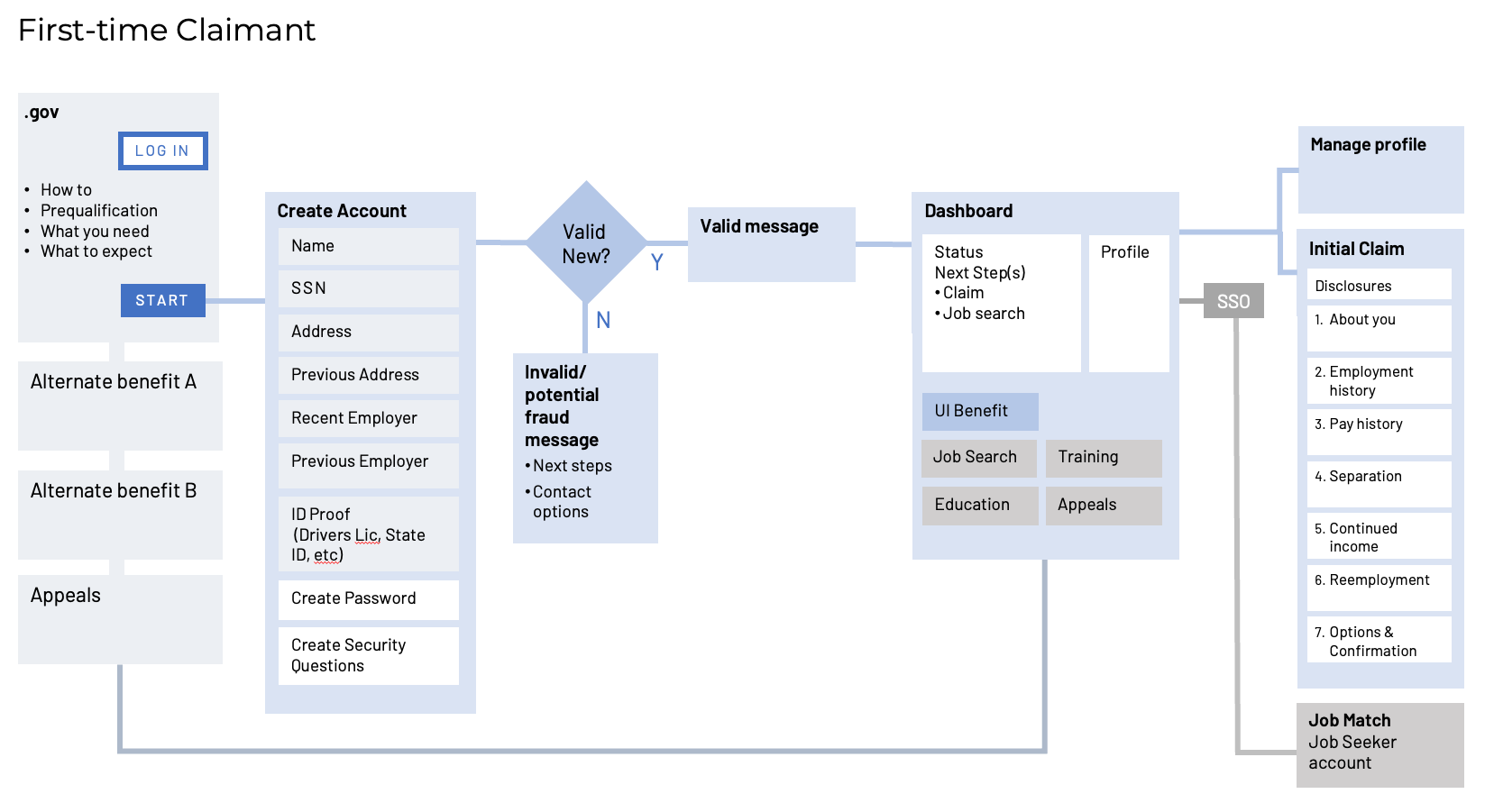Unified unemployment claim
case study
My contributions
I helped conduct and assess both generative research and usability interviews, but was primarily responsible for:
Information architecture – Worked with technical architects to developed experience and process flow diagrams for initial and revised claims, determinations, and appeals.
Plain language writing – Reframed or rewrote application questions, tools tips, conditional instructions, attestations, determinations and status messages to unify four current benefit programs.
Development support – Incorporated QA and UAT testing scenarios in the flows and question bank, and worked with both data architects and front end developers to map questions to data inputs and outputs.
A relatively simple diagram illustrating my proposed unified experience for state unemployment claims. The concept, however, needed to be validated in detail.
Objective
Inundated with unemployment insurance claims at the start of the pandemic, this state needed to revamp their antiquated system to speed response for applicants, and unburden agents and adjudicators by automating rote processes and decisions.
New pandemic-related benefit programs were meant to ease the burden for more classes of unemployed, but in fact were slowing responses and adding to applicant frustration and confusion. The state wanted better web-based applications that could be processed in near real-time.
I established both wording and formatting principles for accurate and accessible data capture.
Real pain revealed via research
The state wisely combed their feedback records to recruit frustrated applicants willing to discuss their experiences.
We interviewed dozens of these newly or recently unemployed to uncover two common pain points:
delayed or missing claim status feedback, and
the inscrutible multiplicity of applications and fact-finding questionnaires that seemed to keep asking the same questions while delaying claims for weeks or months.
Organizing principle for a single claim application that could accommodate all income, separation and availability scenarios, and all potential benefit program types—eliminating most needs for delaying follow up and repeated status requests.
Technology meets plain language
Rather than merely re-writing and re-platforming the existing mix of program claim applications, I worked with data and systems architects to combine all potential queries into single, integrated process with some important benefits:
a single-session application to determine monetary and non-monetary eligibility for any state or federal unemployment benefit program
conditionally triggered, real time data collection to eliminate delayed follow-ups and frustrating redundancy
a consistent organization and flow to accommodate changes in rules or programs without re-invention.
Each question was reconsidered for clarity, and compared to previous versions for approval.
A living library
To demonstrate the validity and comprehensiveness of the new approach, I developed a Question Bank—a library of all potential questions, answers, instructions, and messages that:
compared proposed language to previous for assessment and approval,
tracked all potential conditional relational triggers, formats, and responses,
tied content to required or generated data fields in the anticipated architecture.
The “Qbank” contained over 900 entries, accounting for
all questions in all initial and weekly claims and appeals,
all related tool tips, conditional instructions, and validation error messages, and
resulting conditional declarations and attestations.
The Qbank is used for content revision and approval with the agency, requirement documentation for product managers and developers, and to map scenarios for both quality assurance and user acceptance testing.
The full question bank includes before and after order and content, format assignment, required or resulting data mapping, conditional dependencies—and accounts for all programs and scenarios, including appeals.
Results
While not a sexy-looking interface itself, the Qbank and accompanying flows and formatting principles are essential to prove the concept and lay the foundation for a simpler, more humane approach to unemployment benefit determination and delivery.





